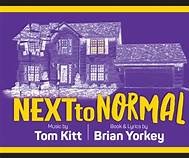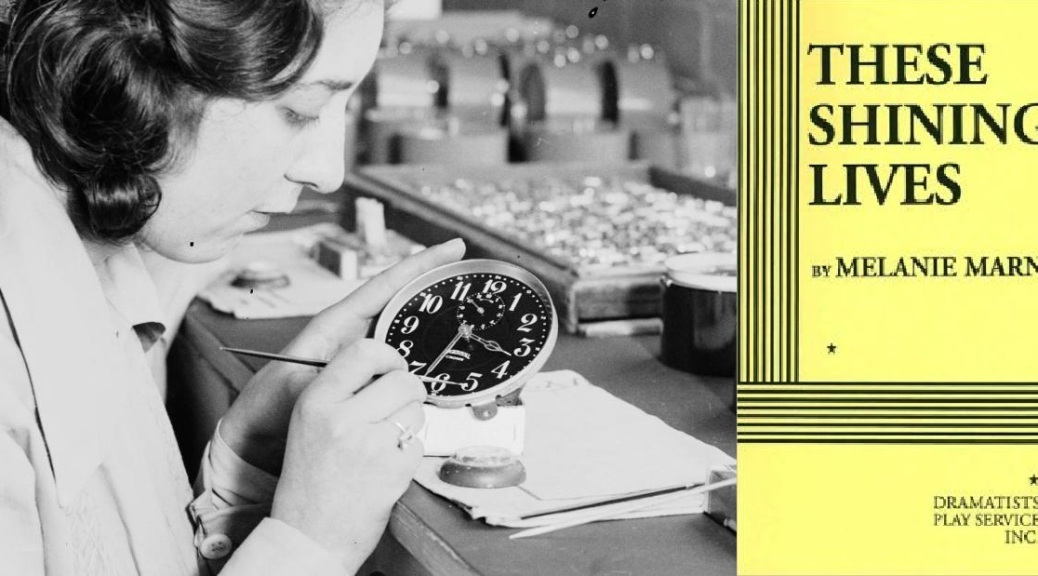April 5, 2019, I opened my production of the 2009 Tony Award and Pulitzer Prize winning musical Next to Normal with book and lyrics by Brian Yorkey and music by Tom Kitt. I was beyond proud of my mostly agricultural MidWestern community for promoting, producing, performing, attending and supporting this groundbreaking and difficult step forward in their main stage subscriber season.
2010 Census Statistics for the county of the production*: Population: 100,000; 45,000 households/30,000 families; Racial makeup: 93.2% White, Latino, 8.0%, 1.9% Black or African American, 0.7% Asian, 0.3% American Indian, 2.5% from other races, and 1.4% from two or more races; Median age: 41.0; Median household income: $52,000 ; Population below the poverty line: 10.8%; Largest industries: Manufacturing (7,000), Health Care & Social Assistance (7000), Retail Trade (7000); Highest paying industries: Utilities ($95,000), Mining, Quarrying, & Oil & Gas Extraction ($63,000), Public Administration ($57,000); Political lean: Republican; High school or higher: 89%; Bachelor’s degree or higher: 18%; Religious: 61%; Catholic: 41%; Christian, other:. 22%; Jewish: 0.11%; Islam: 0.00%
*numbers are rounded to leave the county anonymous
As I was (edit TPT 7/18/21) a member of an area summer stock’s season think-tank and the writer of this blog, I am deliberately educated in new works, and was already enamored of Next to Normal. The theatre where I directed the show sponsors a “Director’s Workshop” in January of the year before it’s January-December season. A director must submit an application, and elect a predetermined time slot in which to produce the show. The board reads/audits and votes for submissions. Winning submissions are welcomed in Winter, Spring, Summer, off-season, and Fall. Imagine my thrill when the new voices on the selection committee offered this choice in a stack of “shows they’d like to see at our theatre!” Despite in-script approved language substitutions, I agreed to do the show only if using all the original dialogue and lyrics. I was not going to repeat a previous mandate from the same theatre to make substitutions. I believe the result was something of which I and our production team, actors, theatre, and our patrons and community should be proud. What follows is a review of that success, production challenges, and “wish-I-wouldas” from my contemplation of the show after its closing.
My direction: A director at this theatre gets approximately 9 weeks to mount a show. You are practically building and directing the show on the same stage simultaneously. I believe an environment was created in which actors, and technical staff felt empowered to be part of the creative work and honored each other‘s decisions. Critically, it would’ve been best for me to take more time before rehearsals began to create blocking. I have become very accustomed to an improvisational directing style with a three-day (approximately 7 hours) rehearsal week. The show demanded more dictated decisions supported by pre-planning, for which I had not prepared. Choreography should have been created before the first rehearsal by a choreographer who was on the production team months earlier. That choice would have given me more time to spend on acting, my forte. I had four rehearsals per week and could have used more. I would, in the future, probably only attend 2 to 3 per week, and let the choreographer and/or music director do their job while I used the night for family or for planning for my blocking and acting rehearsals. My actors did a fine job, but they would have benefited from more intensive work. Diana, especially and others had to create far too much of their own stage business. Summoning my internal Ivo van Hove, I controversially added an ensemble, 4 actresses dressed in scrubs who made the scene changes move quickly and seamlessly.. They acted as invisible commentators and metaphorical puppeteers, and most often added to the involvement of our audience in the action.I wish I had given them more to do in Act 2. You may remind me that the show won awards without them.
Casting: We were stretched at auditions by a production of Mamma Mia casting at the same time. As always, we were short on MALES, MALES, MALES. I seriously wanted to have a more diverse cast (mixed race family, non-white Henry, Doctor), but turnout and area demographics won out again to the overwhelming whiteness of our area. During my rehearsal process, I was hampered by the loss of two ensemble members, who left the production for personal emotional health reasons, and the recurring health concerns of another. This made some of the choral work (and direction) more difficult to manufacture and I had to make some changes, even near opening. I had a marvelous cast. They bonded and often made up for my occasional lack of planning and vision. My Dan was a former professional dancer who saved my unplanned heiny. We brought several new voices and talent to our theatre who were inspired to continue their association with other area theatres.
Music: I could never have had a better musical director! Development of the choral work was inspired. All I needed to do was say, “…and the ensemble sings here.“ At this point, she created the vocal parts. DO NOT do this show without a separate music director who works in collaboration with the primary director. Vocally, this show must be mic’d. The vocal dynamics are too demanding for non-professionals with demanding day-jobs to safely attempt without them. Due to the ever-present difficulty and labor of finding volunteer musicians, I made the decision to go with an excellent pre-recorded score by ROCS. The show would have been richer with a live band. We have no pit, so I would have put them in full view somewhere. As a result, my music director ran the score with one hand while conducting with a small flashlight in the other!
Lights: For the most part the decisions (colors, fades, intensity) for lighting were mine based on instruments hung by a technician who is ahead of me in understanding the board. I know what I like, but I’m not skilled enough to achieve it., The second level was constantly underlit, and used too few instruments. The stairs should’ve had at least two more lighting instruments alone since there was so much action on them. Unfortunately, my operator’s health made it impossible for us to develop the design fully.
Set: We had a horrendous time getting a set design and could get no crew to assist us. This is not anybody’s fault but it was highly unfortunate. I ended up designing the set myself. The paneled rustic modern cross section of a home was gloriously executed by a community member in the skilled trades. The “paneling” was his interpretation of a fleeting idea of mine, and the slider doors were all his. He even encouraged me to use more color upstage and underneath. The pipe and board stair rail was his, as was the rolling crate/table. I wish that we would have built the consoles and the benches for the second level to make them more integrated into the set. Stylized windows and an arch from the original design were omitted for time constraints but would have seriously reinforced the “house“ design. It would’ve been nice to create a way to “fly“ the roofline in and out because it blocked lights. I had many, many compliments on the ease of having characters appear and scene changes occur because of these barn doors. An upstage “mountain mural” was a late thought. I wish the clouds had been painted more realistically and the entire work executed in only shades of brown. It would’ve been nice to hang black curtains in such a way that we had a larger mural. The stairs that were exposed to the audience upstage center were functional. However, I wanted to achieve floating stairs for a more high-style architectural design.
Sound: We had to bring in several monitors and it was barely enough. From an audience perspective, it really sounded like the singing was coming directly from the stage and allowed a great deal of subtlety and range for the actors. I’m glad that we chose to mic everyone. Again, I wish I had been brave enough and worked early enough to have a live band.Costumes: As with many community theatres mounting contemporary shows, most items were pulled from the actor’s own closets. I wish we had taken more time. It worked, but we needed more details for Natalie, and Gabe. This would have been helpful for the audience to understand more about their characters.
Production team: My producers were responsive, supportive and involved. Because there are so few producers who work with our theatre, they were involved with other shows and weren’t available to me as early as I would’ve liked. An ensemble member was fabulous at doing double duty. Many directors love to have their hands in all the pies. I would rather have people with creative opinions and experience that only require me to say yes and no and “great, but more purple.“
Production facilities: The theatre in which it was produced is a dream for a company like ours when it comes to her physical plant. I learned far too late how versatile the second floor was for rehearsals. I had never realized it was so large and fitting for blocking rehearsals. The theatre: Converted two-screen movie theater; Classic proscenium; Playing space approximately 30” deep, 100: wide; Stage right: a corridor Stage left deck is ¾ the size of the playing space; 166 seats; Sound and lights: fairly modern; Pit: none; Greenroom; 2 moderate community dressing rooms; Storage for costumes, props and stock set pieces; 2nd floor: storage, makeup tables, rehearsal space, offices, lighting booth; Lobby with seating and a refreshments bar; On-street and rear parking; Located in an active business district with stores, restaurants, and bars
Board support: As I have mentioned before, I am very proud of our area community theatre for putting this in their main season. It was a bold step. Some improvements: I asked a couple of email questions of board members. They were group emails, and both went unanswered. Perhaps because they were group emails, possibly because some people may not have have my email address in their contacts so the messages never got to him and went straight to junk. Perhaps, I didn’t follow the correct protocol.
Concert Show: My emails were about, and I would still like to consider, “concert productions“ of this work if we could still get the cast together. This is probably moot point one year later. I suggested that we appeal to surrounding theaters and ask them to pay royalties, and provide sound and lights. They would collect the ticket sales themselves to offset costs. I would have liked to offer a premium per performance to actors, and musicians if we need them. Music would be a problem. The show needs at least a piano, guitar, and a drummer, or one would need to pay for the digitized music again. This would add far more expense to the “concert venues“ and may make this too expensive for other theaters to undertake for one night performances. I still believe investigation of the concept is worthwhile even if it is never successful for Next to Normal.
In summation, thank you to the universe for this absolutely wonderful opportunity to work on a beautiful piece. Hopefully, it has emboldened theatre community and new and young directors, brought new people to the theater who have never been there before, and given our community something they can sink their teeth into and be inspired.










